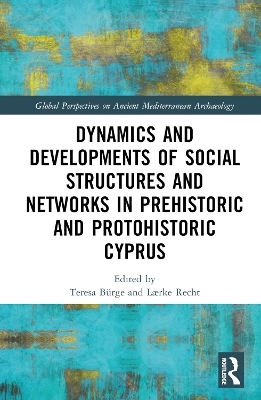
Dynamics and Developments of Social Structures and Networks in Prehistoric and Protohistoric Cyprus
Routledge (Verlag)
978-1-032-33540-7 (ISBN)
The Cypriot Neolithic, Chalcolithic, and Bronze Age are characterised by an increasing complexity of social and political organisation, economic systems, and networks. The book discusses and defines how specific types of material datasets and assemblages, such as architecture, artefacts, and ecofacts, and their contextualisation can form the basis of interpretative models of social structures and networks in ancient Cyprus. This is explored through four main themes: approaches to social dynamics; social and economic networks and connectivity; adaptability and agency; and social dynamics and inequality. The variety and transition of social structures on the island are discussed on multiple scales, from the local and relatively short-term to island-wide and eastern Mediterranean-wide and the longue durée. The focus of study ranges from urban to non-urban contexts and is reflected in settlement, funerary, and other ritual contexts. Connections, both within the island and to the broader Eastern Mediterranean, and how these impact social and economic developments on the island, are explored. Discussions revolve around the potential of consolidating the models based on specialised studies into a cohesive interpretation of society on ancient Cyprus and its strategic connections with surrounding regions in a diachronic perspective from the Neolithic through the end of the Bronze Age, i.e. from roughly the seventh millennium to the eleventh century BCE.
Dynamics and Developments of Social Structures and Networks in Prehistoric and Protohistoric Cyprus is intended for researchers and students of the archaeology and history of ancient Cyprus, the Aegean, and the Eastern Mediterranean.
Teresa Bürge is Postdoctoral Research Fellow at the Universities of Gothenburg and Bern, and at the Austrian Academy of Sciences. Her research focuses on the Bronze and Iron Ages in the Eastern Mediterranean and the Levant, in specific pottery and pottery provenance studies, economy, trade and exchange of goods, as well as depositional practices, ritual, and cult. She has co-directed the Swedish excavations at Hala Sultan Tekke, Cyprus, and is the expedition’s ceramic expert. Lærke Recht is Professor of Early Eastern Mediterranean Archaeology, Institute of Classics (Ancient Eastern Mediterranean Studies), University of Graz, and Research Fellow at the International Institute for Mesopotamian Area Studies. Her main research interests are the Bronze Age and prehistory of Cyprus, Mesopotamia, and the Aegean, in particular material culture studies, human-animal relations, and exchange networks. She conducts excavations in Cyprus at Erimi-Pitharka and is a part of the Tell Mozan Project in Syria.
1. Introduction: connecting multiple approaches to social structures and networks; 2. Material convergences in a globalising world? Cyprus and the Near East in the seventh and sixth millennia BCE; 3. Economic convergences in a globalising world? Cyprus and the Near East in the seventh and sixth millennia BCE; 4. A multi-proxy approach to human-environment-climate coevolution in prehistoric and protohistoric Cyprus; 5. Rethinking the emergence of social inequalities: the case of Chalcolithic Cyprus; 6. Metal artefact production and distribution in Early and Middle Bronze Age Cyprus: patterns of intraregional and interregional connection and disconnection; 7. Intraregional and interregional connections on Cyprus between MC III and LC I in the regions of Limassol and Paphos; 8. Innovation and adaptation: ceramic development across the Middle to Late Cypriot horizon; 9. Cypriot connections through the Middle to Late Bronze Age transition in the Western Galilee: a review of residual Cypriot pottery from Tel Achziv; 10. Strategies for success during the transition to the Late Bronze Age at Kissonerga-Skalia; 11. The social context of ritual in Late Bronze Age Cyprus: an archaeobotanical study from the cemetery of Hala Sultan Tekke; 12. Of bulls and birds: Mycenaean and Cypriot animal and social symbolism on the move; 13. Eastern Mediterranean exchange networks: imported ceramics at Pyla-Kokkinokremos, Cyprus; 14. Pyla-Kokkinokremos (Cyprus) and Late Bronze Age Mediterranean networks: the role of the pithoi; 15. Pursuits of social status and power at Maa-Palaeokastro; 16. Connecting communities: agency and social interactions in prehistoric and protohistoric Cyprus
| Erscheinungsdatum | 20.12.2023 |
|---|---|
| Reihe/Serie | Global Perspectives on Ancient Mediterranean Archaeology |
| Zusatzinfo | 8 Tables, black and white; 95 Halftones, black and white; 95 Illustrations, black and white |
| Verlagsort | London |
| Sprache | englisch |
| Maße | 156 x 234 mm |
| Gewicht | 640 g |
| Themenwelt | Geisteswissenschaften ► Archäologie |
| Geschichte ► Allgemeine Geschichte ► Vor- und Frühgeschichte | |
| Geschichte ► Teilgebiete der Geschichte ► Kulturgeschichte | |
| Geschichte ► Teilgebiete der Geschichte ► Sozialgeschichte | |
| ISBN-10 | 1-032-33540-8 / 1032335408 |
| ISBN-13 | 978-1-032-33540-7 / 9781032335407 |
| Zustand | Neuware |
| Informationen gemäß Produktsicherheitsverordnung (GPSR) | |
| Haben Sie eine Frage zum Produkt? |
aus dem Bereich


